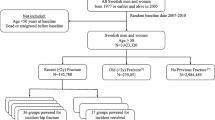Abstract
Summary
Using the claim database, we investigated the incidence rate of clinical vertebral fractures per 1,000 in the elderly residents, over 65 years of age, in Kure city. The incidence rate, of clinical vertebral fractures, was 15.58 (7.29 male, 21.17 female, 2.90 female/male ratio).
Purpose
To elucidate the incidence of clinical vertebral and hip fractures using the claim database, in those over 65 years of age in Kure city, and to compare with the previous reports.
Methods
We used, for residents in 2015, the medical care information of the National Health Insurance or Senior Elderly Care System in Kure City (Hiroshima Prefecture, Japan). Those with vertebral fractures as disease name, and either treatment/operation/hospitalization were defined as clinical vertebral fractures. Among the claim database, we extracted the clinical vertebral fracture and investigated the number of occurrences and the incidence rate per 1,000. We also investigated the incidence rate of hip fractures and compared those to the clinical vertebral fractures.
Result
The incidence rate of clinical vertebral fractures of the elderly population (65 years or over) per 1,000 was 15.58 (7.29 male, 21.17 female, 2.90 female/male ratio). In both men and women, the incidence rate increased with aging. The incidence rate of hip fractures per 1,000 was 9.17 (3.55 male, 12.96 female, 3.65 male/female ratio). Clinical vertebral fractures were more frequent than hip fractures, and the ratio of incidence rate of vertebral fractures to hip fractures was 1.70 (male, 2.05, female, 1.63). For both fractures, the incidence rate increases with age, apart from the women where the incidence of vertebral fracture reduces slightly in the older age group
Conclusion
This is the first report that investigated the incidence rate of the clinical vertebral fractures using the claim database, which covered almost the whole number of 230,000 population area.

Similar content being viewed by others
References
Fujiwara S, Kasagi F, Masunari N, Naito K, Suzuki G, Fukunaga M (2003) Fracture prediction from bone mineral density in Japanese men and women. J Bone Miner Res 18:1547–1553
Cauley JA, Thompson DE, Ensrud KC, Scott JC, Black D (2000) Risk of mortality following clinical fractures. Osteoporos Int 11(7):556–561
Orimo H, Yaegashi Y, Hosoi T, Fukushima Y, Onoda T, Hashimoto T, Sakata K (2016) Hip fracture incidence in Japan: estimates of new patients in 2012 and 25-year trends. Osteoporos Int 27:1777–1784
Kanis JA, Oden A, EV MC, Johansson H, Wahl DA, Cooper C, IOF Working Group on Epidemiology and Quality of Life (2012) A systematic review of hip fracture incidence and probability of fracture worldwide. Osteoporos Int 23(9):2239–2256
Hagino H, Endo N, Harada A, Iwamoto J, Mashiba T, Mori S, Ohtori S, Sakai A, Takada J, Yamamoto T (2017) Survey of hip fractures in Japan: recent trends in prevalence and treatment. J Orthop Sci 22(5):909–914
Tamaki J, Fujimori K, Ikehara S, Kamiya K, Nakatoh S, Okimoto N, Ogawa S, Ishii S, Iki M, Working Group of Japan Osteoporosis Foundation (2019) Estimates of hip fracture incidence in Japan using the National Health Insurance Claim Database in 2012–2015. Osteoporos Int 30(5):975–978
Ballane G, Cauley JA, Luckey MM, El-Hajj Fuleihan G (2017) Worldwide prevalence and incidence of osteoporotic vertebral fractures. Osteoporos Int 28(5):1531–1542
Lix LM, Azimaee M, Osman BA, Caetano P, Morin S, Metge C, Goltzman D, Kreiger N, Prior J, Leslie WD (2012) Osteoporosis-related fracture case definitions for population-based administrative data. BMC Public Health 12:301
Balasubramanian A, Zhang J, Chen L, Wenkert D, Daigle SG, Grauer A, Curtis JR (2019) Risk of subsequent fracture after prior fracture among older women. Osteporos Int 30(19):79–92
Tsukutani Y, Hagino H, Ito Y, Nagashima H (2015) Epidemiology of fragility fractures in Sakaiminato, Japan: incidence, secular trends, and prognosis. Osteoporos Int 26(9):2249–2255
Imai N, Endo N, Shobugawa Y, Oinuma T, Takahashi Y, Suzuki K, Ishikawa Y, Makino T, Suzuki H, Miyasaka D, Sakuma M (2019) Incidence of four major types of osteoporotic fragility fractures among elderly individuals in Sado, Japan, in 2015. J Bone Miner Metab 37(3):484–490
Ministry of Health, Labour and Welfare HP. https://www.mhlw.go.jp/english/. Accessed 4 Aug 2020
Kure City HP. https://www.city.kure.lg.jp/site/userguide/foreign.html. Accessed 4 Aug 2020
Bow CH, Cheung E, Cheung CL, Xiao SM, Loong C, Soong C, Tan KC, Luckey MM, Cauley JA, Fujiwara S, Kung AW (2012) Ethnic difference of clinical vertebral fracture risk. Osteoporos Int 23(3):879–885
Imai N, Endo N, Shobugawa Y, Oinuma T, Takahashi Y, Suzuki K, Ishikawa Y, Makino T, Suzuki H, Miyasaka D, Sakuma M (2014) Incidence of osteoporotic fractures in Sado, Japan in 2010. J Bone Miner Metab 32:200–205
Black DM, Cummings SR, Karpf DB, Cauley JA, Thompson DE, Nevitt MC, Bauer DC, Genant HK, Haskell WL, Marcus R, Ott SM, Torner JC, Quandt SA, Reiss TF, Ensrud KE (1996) Randomised trial of effect of alendronate on risk of fracture in women with existing vertebral fracturesFracture Intervention Trial Research Group. Lancet 348:1535–1541
Acknowledgments
The authors sincerely acknowledge Dr. Yutaka Hara and Dr. Masaharu Tamaki at the Kure Medical Association for supporting our study. The authors express their sincere appreciation to Ms. Shoko Maeno and Ms. Yayoi Kanameda at Kure City (Health and Welfare Section, Insurance Pension Section) for their public support. The authors also acknowledge Mr. Koki Yoneda at Data Horizon Cooperation, for his data analysis. The help in English language was given by Emeritus Professor Orthopedics, Dr. William C. Hutton (Emory University School of Medicine).
Author information
Authors and Affiliations
Corresponding author
Ethics declarations
Conflict of interest
The authors declare that they have no conflict of interest.
Additional information
Publisher’s note
Springer Nature remains neutral with regard to jurisdictional claims in published maps and institutional affiliations.
Rights and permissions
About this article
Cite this article
Hamasaki, T., Okimoto, N., Teramoto, H. et al. Incidence of clinical vertebral fractures and hip fractures of the elderly (65 years or over) population—large-scale data analysis using claim database in Kure City, Hiroshima, Japan. Arch Osteoporos 15, 124 (2020). https://doi.org/10.1007/s11657-020-00797-2
Received:
Accepted:
Published:
DOI: https://doi.org/10.1007/s11657-020-00797-2




